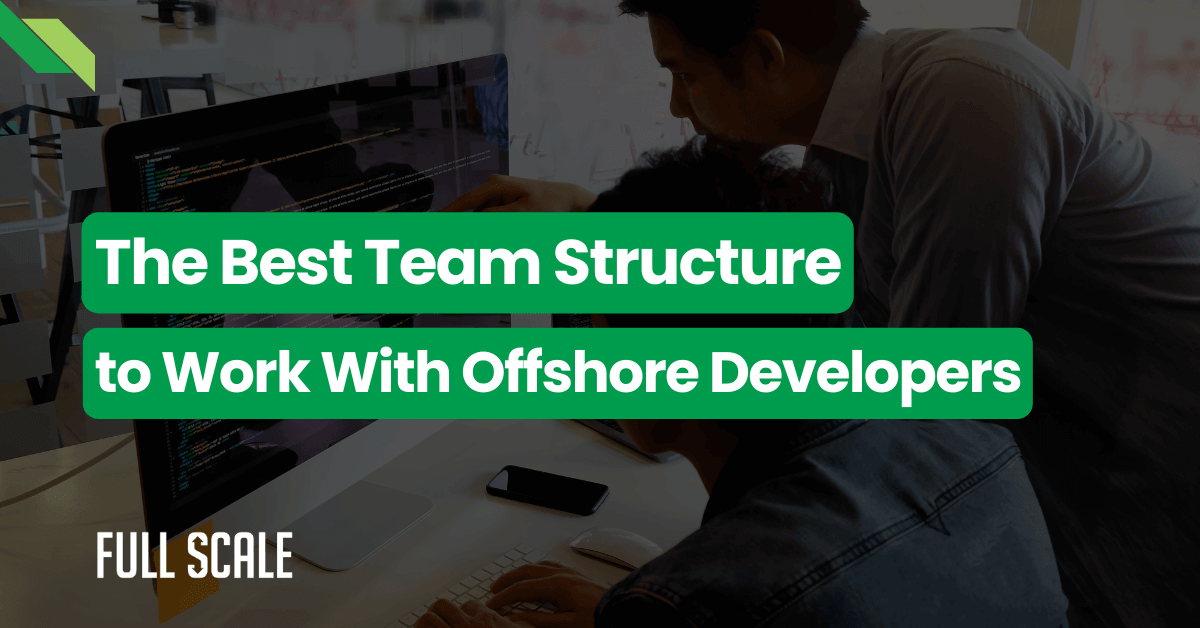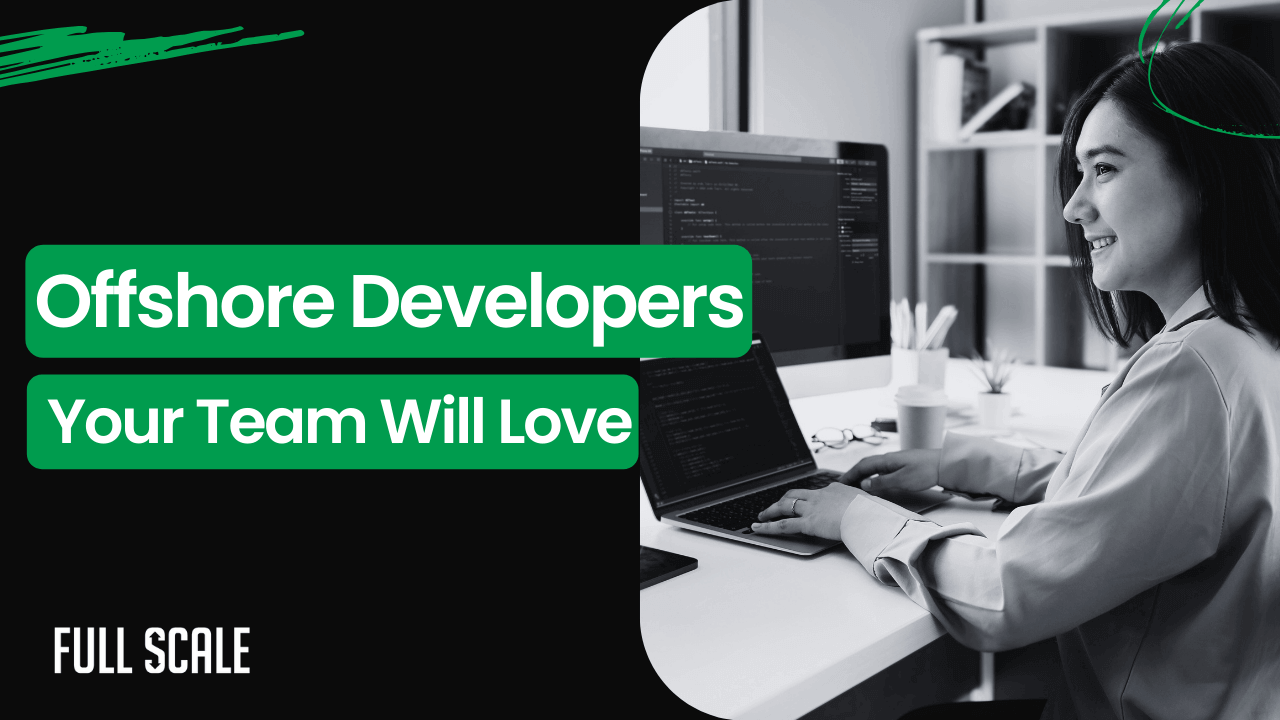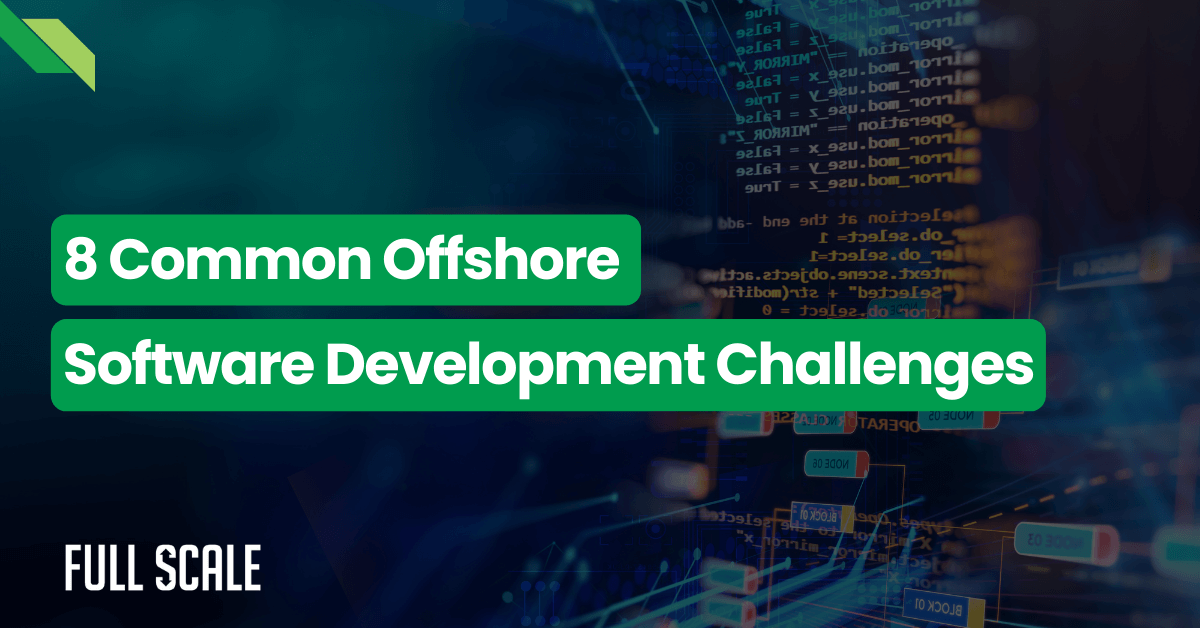Last Updated on 2025-07-08
Companies implementing the agile development BOT model face unique integration challenges. According to Deloitte’s 2024 Global Outsourcing Survey, 78% of enterprises now use agile methodologies in offshore engagements.
The State of Agile Report 2024 shows that distributed agile teams achieve 45% faster delivery than traditional models. At Full Scale, we’ve proven that agile development BOT model success isn’t just possible—it’s predictable with the right approach.
The 30-Second Answer
Yes, the agile development BOT model works when you:
- Establish clear, agile protocols before the Build phase
- Maintain consistent sprint cycles through all three phases
- Use distributed team tools designed for agile ceremonies
- Define transition milestones that don’t disrupt velocity
- Implement knowledge transfer as a continuous documentation
Why Agile Development BOT Model Integration Matters
Many assume that agile development BOT model combinations create impossible contradictions. Full Scale’s experience across 50+ projects proves otherwise.
Let’s examine both challenges and opportunities. Understanding these dynamics helps teams prepare effective solutions.
Understanding the BOT Model
The Build-Operate-Transfer (BOT) model involves three distinct phases. First, vendors build a dedicated team for specific client needs. Next, they operate this team while delivering project outcomes. Finally, they transfer the entire team to client control.

What Makes This Combination Challenging
Traditional BOT emphasizes predictability, while agile values adaptability. These opposing forces create specific friction points in the BOT model agile methodology. Full Scale addresses each systematically. Our proven framework transforms challenges into advantages.
Core Conflicts Between Agile and BOT
| BOT Characteristic | Agile Principle | Resulting Challenge | Full Scale Solution |
| Fixed contracts | Flexible scope | Scope creep concerns | Capacity-based pricing |
| Team transitions | Stable velocity | Productivity drops | Overlapping team phases |
| Heavy documentation | Working software | Time allocation conflicts | Automated documentation |
| Geographic distribution | Face-to-face communication | Collaboration barriers | Structured async processes |
Why Companies Still Choose Agile + BOT
Despite challenges, our clients report significant advantages with agile BOT implementations. The data demonstrates the tangible benefits of this approach. Full Scale tracks these metrics across all BOT engagement agile teams. Results consistently favor the agile development BOT model approach.
Agile BOT Performance Metrics
| Metric | Traditional BOT | Agile BOT | Improvement |
| Time-to-market | 8-12 months | 4-8 months | 40% faster |
| Defect rates | 15-20% | 10-13% | 35% lower |
| Knowledge retention | 60% | 90% | 50% better |
| Client satisfaction | 6.5/10 | 8.1/10 | 25% higher |
Phase-by-Phase Implementation for Agile Development BOT Model Success
Each BOT phase requires specific adaptations for the agile transformation of offshore teams. Full Scale’s methodology addresses unique challenges at every stage. Our systematic approach ensures smooth transitions between phases. Teams maintain productivity throughout the entire agile development BOT model engagement.
Build Phase: Setting the Foundation
The build phase determines long-term success in any agile development BOT model. Full Scale embeds agile practices from day one. Early investment in a proper setup pays dividends later. Most BOT failures are traced back to weak foundations.
Critical Success Factors
Our build-operate-transfer agile approach starts with embedding coaches. These experts establish ceremonies before writing any code. Sprint Zero focuses on environment setup and team alignment. Every team member understands the Definition of Done.
Key infrastructure for the agile development BOT model includes:
- Automated testing frameworks for distributed teams
- CI/CD pipelines accessible from the Philippines locations
- Shared repositories with version control
- Overlap schedules for collaboration
Common Pitfalls to Avoid
Many teams rush development without establishing a proper BOT model agile methodology.
This creates technical debt and communication breakdowns later. Full Scale mandates the ceremony establishment before sprint one. Time zone planning prevents future collaboration issues.
Operate Phase: Maintaining Momentum
The operate phase tests agile BOT sustainability and team resilience. Teams deliver consistent value while preparing for the transition. Full Scale focuses on velocity stability during this period. Success requires balancing productivity with knowledge transfer preparation.
Velocity Optimization Strategies
Stable composition drives predictable velocity in BOT engagement agile teams. Full Scale maintains core members for a six-month minimum period. This stability enables accurate BOT model sprint planning commitments. Architectural Decision Records capture critical technical choices.
Velocity Optimization Tactics
| Strategy | Implementation | Impact on Velocity | Measurement |
| Stable teams | 6-month minimum tenure | +25% after month 3 | Story points/sprint |
| ADR documentation | Weekly architecture reviews | -5% initially, +15% long-term | Decision retrieval time |
| Client involvement | Product owner in ceremonies | +20% requirement accuracy | Rework percentage |
| Regular retrospectives | Bi-weekly with action items | +10% continuous improvement | Team satisfaction scores |
Transfer Phase: Seamless Handover
The transfer phase often disrupts agile momentum in traditional models. Full Scale’s agile development BOT model maintains velocity during transfer. Client teams integrate gradually without stopping feature delivery. This method ensures business continuity throughout the transition.
Knowledge Transfer Without Disruption
A successful transfer in the agile development BOT model begins early. Full Scale implements pair programming in final sprints. Client developers work alongside our Philippine teams. This hands-on approach beats traditional documentation handoffs.

Tools and Processes for Distributed Agile Teams BOT
Distributed agile teams BOT require specialized tooling and processes. Full Scale refined our stack through extensive experience. Each tool serves specific collaboration needs across APAC time zones. Integration between tools minimizes context switching overhead.
Essential Tool Stack
Tool selection significantly impacts the agile development BOT model’s success. Full Scale standardizes on proven platforms for consistency. Training begins during onboarding for all team members. Regular reviews ensure optimal tool adoption rates.
Full Scale’s Agile BOT Tool Stack
| Category | Primary Tool | Secondary Tool | Monthly Cost | Key Features |
| Communication | Slack | Microsoft Teams | $8/user | Async updates, channel organization |
| Video Conferencing | Zoom | Google Meet | $15/user | Recording, breakout rooms |
| Project Management | Jira | Azure DevOps | $10/user | Sprint planning, burndown charts |
| Documentation | Confluence | Notion | $5/user | Version control, templates |
| Code Collaboration | GitHub | GitLab | $9/user | PR reviews, CI/CD integration |
Modified Agile Ceremonies
Traditional ceremonies need adaptation for offshore agile development BOT. Full Scale modifies each ceremony for distributed effectiveness. These adaptations maintain agile principles while acknowledging constraints. Time zones become manageable rather than blocking progress.
Agile Development BOT Model Readiness Assessment
Evaluate your organization’s readiness for agile BOT implementation
Your Agile BOT Readiness Score
Recommendations for Your Organization:
Cost-Benefit Analysis for Agile Development BOT Model
Financial stakeholders need clear ROI data for agile BOT best practices. Full Scale provides transparent cost breakdowns upfront. Understanding total costs prevents budget surprises later. Investment in an agile development BOT model pays off quickly.
Real Costs of Implementation
Implementing the BOT model agile methodology requires an initial investment. Coordination overhead ranges from 15% to 20% of team capacity. Full Scale includes these costs in project estimates. Transparency helps clients make informed decisions.
Agile BOT Cost Breakdown
| Cost Category | Monthly Amount | Duration | Total Investment | ROI Timeline |
| Coordination overhead | 15-20% capacity | Ongoing | $3,000-4,000/month | Month 3 |
| Tool licenses | $50-100/developer | Ongoing | $500-1,000/month | Immediate |
| Agile coaching | $150-200/hour | 3 months | $24,000-32,000 | Month 4 |
| Reduced velocity | 20-30% capacity | 2 months | $8,000-12,000 | Month 3 |
Measurable Benefits
Full Scale tracks benefit across all agile development BOT model engagements. Returns typically exceed investments by month four. Long-term gains significantly outweigh initial costs. These metrics convince even skeptical stakeholders.

Agile Development BOT Model ROI Calculator
Cost Analysis
Traditional BOT
Agile BOT (Full Scale)
Total Savings with Agile BOT
ROI Timeline: 0 months
Common Objections and Solutions
Stakeholders raise predictable concerns about the agile challenges BOT projects face. Full Scale addresses each with proven solutions. Experience guides our recommended approaches for success. Data supports every agile development BOT model recommendation.
“BOT needs a fixed scope, Agile changes everything.”
This misunderstands both BOT and agile principles fundamentally. Full Scale uses fixed capacity with flexible scope. Clients purchase team hours, not specific features. Change management handles scope adjustments transparently.
“How do we maintain quality during transitions?”
Quality concerns spike during agile transformation offshore team transitions. Full Scale maintains standards through comprehensive automated testing. Coverage exceeding 80% ensures consistent quality delivery. Continuous integration catches issues before production deployment.
“Time zones kill agile collaboration.”
Time zone challenges are manageable with proper planning. Full Scale leverages the Philippines’ favorable timezone for global clients. APAC location provides optimal overlap with the US and European markets. Teams adapt quickly to distributed agile development BOT model rhythms.
Success Checklist for Agile Development BOT Model
Full Scale’s checklist ensures readiness for BOT engagement for agile teams. Use this before starting any Agile development BOT model project. Regular reviews maintain alignment throughout the engagement. Completion correlates strongly with project success rates.
Agile Development BOT Model Success Checklist
Track your readiness and progress through each phase
Ready to Start Your Agile BOT Journey?
Full Scale’s Philippine teams have mastered the agile development BOT model
Explore Our ServicesMaking Your Agile Development BOT Model Work
Success depends on project context and team readiness. Full Scale helps evaluate fit for your specific needs. Some projects benefit more from this approach. Clear criteria guide these important decisions.
When Agile + BOT Works Best
Certain projects thrive with agile development BOT model approaches. Full Scale recommends this for dynamic requirement projects. Complex integrations benefit from iterative development cycles. Product development sees the greatest efficiency gains.
When to Consider Alternatives
Some projects don’t suit agile BOT best practices well. Full Scale identifies these during initial consultations. Alternative approaches may sometimes deliver better results. Honesty about fit builds lasting client trust.
Start Your Agile BOT Journey with Full Scale
The agile development BOT model requires expertise and proven methodologies. Full Scale brings both to every engagement we undertake. Our Philippine teams excel at distributed agile practices. Start with these concrete steps today:
- Assess your team’s agile maturity level
- Define success metrics for BOT engagement
- Evaluate Full Scale’s proven expertise
- Begin with a pilot project
Ready to transform your development with agile BOT excellence?
Full Scale’s offshore development services deliver proven agile BOT success. Our teams in the Philippines have mastered distributed agile delivery. With 50+ successful agile development BOT model implementations, we’re ready to accelerate your project.
Contact us to discuss how Full Scale can make your agile BOT vision a reality.
Explore Our Services to Help with Agile Transformation
FAQs: Agile Development BOT Model
How long does it take to implement the agile development BOT model successfully?
The agile development BOT model typically requires 12-18 months for complete implementation:
- Build phase: 2-3 months for team assembly and agile foundation
- Operate phase: 8-12 months for stable velocity and feature delivery
- Transfer phase: 2-3 months for seamless handover
Success timelines vary based on project complexity and team experience with the BOT model agile methodology.
What are the main risks when combining agile transformation with offshore teams and BOT?
Key risks in agile development BOT model implementation include:
- Time zone coordination – Solved with 4-hour overlap requirements
- Knowledge transfer gaps – Mitigated through continuous documentation
- Velocity drops during transitions – Managed with overlapping team phases
- Cultural alignment issues – Addressed through embedded agile coaches
- Scope creep concerns – Handled via capacity-based pricing models
Can the agile development BOT model work for small teams?
Yes, agile BOT best practices scale effectively for teams as small as 3-5 developers:
- Minimum viable team: 3 developers + 1 QA engineer
- Ideal for projects with 6+ month timelines
- Cost benefits remain significant even at a small scale
- Simplified BOT model sprint planning for smaller groups
However, teams under three members should consider staff augmentation instead.
How does Full Scale ensure successful agile development BOT model delivery?
Full Scale’s proven approach for BOT engagement with agile teams includes:
- 50+ successful implementations across various industries
- Philippines-based teams providing optimal timezone coverage
- Dedicated agile coaches embedded from day one
- Pre-vetted developers experienced in distributed agile teams BOT
- Transparent pricing with no hidden coordination costs
Our Cebu and Manila offices specialize in build-operate-transfer agile engagements.
What’s the difference between traditional and agile challenges that BOT projects face?
The agile development BOT model addresses traditional BOT limitations:
Traditional BOT:
- Fixed scope requirements
- Waterfall documentation
- Rigid phase transitions
- Limited client involvement
Agile BOT:
- Flexible scope management
- Living documentation approach
- Continuous knowledge transfer
- Daily client collaboration
This fundamental shift enables offshore agile development BOT to deliver 40% faster results.

Matt Watson is a serial tech entrepreneur who has started four companies and had a nine-figure exit. He was the founder and CTO of VinSolutions, the #1 CRM software used in today’s automotive industry. He has over twenty years of experience working as a tech CTO and building cutting-edge SaaS solutions.
As the CEO of Full Scale, he has helped over 100 tech companies build their software services and development teams. Full Scale specializes in helping tech companies grow by augmenting their in-house teams with software development talent from the Philippines.
Matt hosts Startup Hustle, a top podcast about entrepreneurship with over 6 million downloads. He has a wealth of knowledge about startups and business from his personal experience and from interviewing hundreds of other entrepreneurs.




